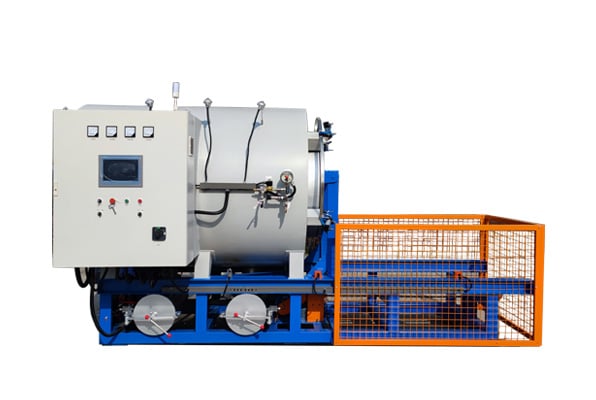Vacuum calcination furnaceshttps://8ruiyan.com/en/all-vacuum-cleaning-furnaces/ play a vital role in polymer processing, primarily used to remove volatiles, enhance thermal stability, and perform specialized heat treatments. To ensure safe and efficient operation, strict adherence to installation standards, proper operating procedures, and maintenance practices is essential. This guide provides detailed instructions on installation requirements, step-by-step operation, and key precautions to help users avoid common issues and extend equipment lifespan.

1. Installation Requirements
1.1 Site and Environmental Conditions
- Space Layout: Maintain at least 1 meter of clearance around the furnace for operation and maintenance, ensuring proper ventilation.
- Floor Load Capacity: The foundation must be stable, with a load-bearing capacity of ≥2 tons/m² to prevent vibrations.
- Ambient Conditions:
- Temperature: 10–30°C (avoid extreme heat or cold)
- Humidity: ≤80% RH (prevent moisture damage to electrical components)
- Keep away from corrosive gases, dust, and flammable/explosive materials.
1.2 Utility Connections
- Power Supply:
- Stable voltage (±10% of rated voltage)
- Independent grounding (ground resistance ≤4Ω)
- Cooling Water System:
- Water pressure: 0.2–0.4 MPa
- Water quality: Deionized or purified water (prevent scaling)
- Flow rate: ≥5 L/min (adjust based on furnace specifications)
- Vacuum System:
- Exhaust pipes should avoid sharp bends to minimize airflow resistance.
- Install a gas treatment unit (especially for halogen-containing polymers).
1.3 Installation Steps
- Positioning & Leveling: Adjust to ≤0.1mm/m levelness for stability.
- Vacuum System Connection: Use high-temperature-resistant seals (e.g., fluoropolymer gaskets).
- Cooling Piping Installation: Avoid kinks to ensure smooth water flow.
- Electrical Wiring: Follow manufacturer diagrams and check insulation.
- Control System Calibration: Verify temperature sensors, vacuum gauges, etc.
2. Operating Procedures
2.1 Pre-Startup Checks
- Inspect furnace door gaskets for wear or damage.
- Check vacuum pump oil level (should be at mid-window mark).
- Ensure cooling water is flowing properly.
2.2 Loading Materials
- Use high-temperature-resistant crucibles or trays for polymer materials.
- Avoid overloading (typically ≤70% of chamber capacity).
- Clean sealing surfaces before closing the furnace door.
2.3 Vacuum Pumping
- Start the mechanical pump to reach 10⁻¹–10⁻² mbar.
- For higher vacuum, switch to a diffusion pump (target 10⁻³ mbar or lower).
- Monitor the vacuum gauge for leaks (pressure should drop steadily).
2.4 Heating Program Setup
- Step Heating (for most polymers):
- Room temperature → 300°C .
- 350°C → Target temperature .
- Cooling Phase:
- Natural cooling or use inert gas (e.g., N₂) for faster cooling.
- Open furnace only when temperature ≤80°C to prevent thermal shock.
2.5 Venting and Unloading
- Turn off heating and vacuum pumps.
- Slowly vent with nitrogen or dry air to atmospheric pressure.
- Open the door and remove materials using heat-resistant tools.
3. Key Precautions
3.1 Safety Protocols
- Personal Protection:
- Wear heat-resistant gloves and safety goggles.
- Use specialized tongs for handling hot materials.
- Prohibited Actions:
- Never exceed maximum temperature limits.
- Avoid rapid cooling (may crack furnace lining).
- Do not process unknown polymers (risk of toxic gas release).
3.2 Routine Maintenance
- Vacuum Pump:
- Check oil level every 100 hours; replace oil every 500 hours.
- Sealing System:
- Inspect door gaskets weekly; replace if aged.
- Heating Elements:
- Measure resistance monthly to detect shorts or breaks.
3.3 Troubleshooting Guide
| Issue | Possible Cause | Solution |
|---|---|---|
| Poor Vacuum | Leaky gasket / Dirty pump oil | Replace gasket / Change oil |
| Temperature Fluctuations | Faulty thermocouple / Controller error | Replace sensor / Check control unit |
| Unusual Noise | Pump failure / Insufficient cooling | Inspect pump / Increase water flow |
| Failure to Start | Power issue / Safety lock engaged | Check power supply / Reset safety switch |
4. Conclusion
Proper installation, operation, and maintenance of vacuum calcination furnaces are crucial for consistent polymer heat treatment. By following this guide’s installation guidelines, operating steps, and safety measures, users can prevent equipment damage, optimize efficiency, and prolong service life. For specialty polymers (e.g., fluoropolymers or elastomers), consult manufacturer-specified parameters for best results.
For technical inquiries, contact Ruiyuan’s official support team!
📞 📞 📞
Whatsapp:86-19106101570
wechat:86-19106101570
email:nieyili@cnryan.com
